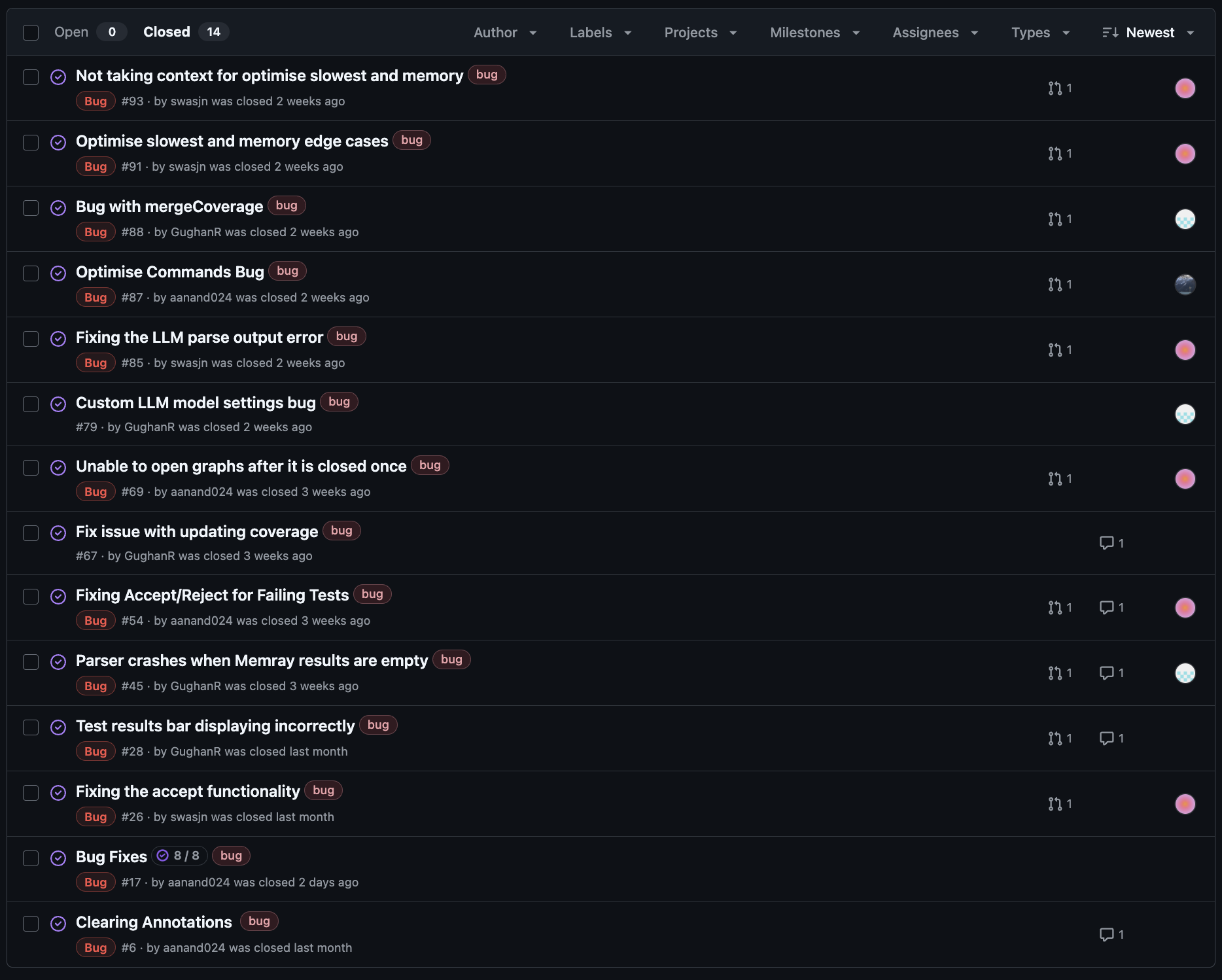We designed UnitPylot’s user interface with the goal of making testing as intuitive and seamless
as possible within the
VS Code environment. From the beginning, we aimed to reduce friction by integrating key visual
elements (the dashboard,
test status indicators, and inline coverage highlights) directly into the editor. Our intention
was to ensure that
developers wouldn’t have to context-switch or leave their workspace to understand their test
suite’s health. The
interface prioritises clarity: we chose minimalist graphs, concise tooltips, and clean layouts to
deliver relevant data
at a glance.
The UI went through multiple iterative improvements driven by user testing. For instance, early
users noted that the
dashboard lacked explanatory legends and that certain coverage indicators weren’t fully intuitive.
In response, we
incorporated hover tooltips, added labels to graphs, and made the inline suggestions more
contextually descriptive. This
iterative refinement process demonstrated a strong feedback loop, where the team worked
collaboratively to ensure every
visual element served a functional purpose. We also improved interaction design by refining
command placement in the
context menu and palette to reduce friction.
Future improvements could include adaptive UI elements based on user preferences or test suite
complexity to further
personalise the experience.
We built UnitPylot with a clear focus on solving real pain points in Python testing. Features like
test execution, code
coverage visualisation, AI suggestions, and snapshot tracking were all grounded in feedback from
developers we spoke to
during our research phase. Rather than being a passive test viewer, UnitPylot actively helps
developers understand and
improve their testing through both automation and insight.
Each major feature went through rounds of refinement. For instance, with the Fix Failing Tests
command, we slowly
expanded the logic to handle real failure output. Our Improve Coverage and Optimise Test Speed &
Memory commands were
developed using hand-crafted examples and edge cases, which we used to evaluate the accuracy of
the AI’s suggestions.
Throughout, we tried to balance intelligent automation with developer control: suggestions are
non-destructive, clearly
explained, and easy to accept or reject.
However, we also encountered functional limitations, especially when dealing with less
conventional Python project
structures. Some files weren’t detected properly if they didn’t follow common naming conventions,
and AI suggestions
occasionally struggled with complex code contexts. While these issues didn’t block core
functionality, they highlighted
the importance of refining our parsing logic and improving the prompts we send to the LLM.
Going forward, we plan to improve our static analysis and introduce more advanced filters to make
the AI’s output
smarter and more context-aware.
Ensuring stability was a major focus throughout the project. Because testing tools are only useful
when reliable, we
aimed to build a system that handled errors gracefully and provided meaningful feedback when
something went wrong. We
wrote unit tests for core modules like the TestRunner, history tracker, and report generator.
These gave us confidence
that the underlying logic was robust even as we introduced new features.
We manually tested the extension across various environments and scenarios—intentionally breaking
tests and running the
extension on both macOS and Windows to confirm that it could handle errors without crashing.
Future improvements could include adding environment checks or fallbacks and better logging to
help users self-diagnose
issues.
Overall, the extension is stable in expected conditions, but we want to make it more
resilient to variability in user setups.
Efficiency was a driving factor behind many of our design choices. Developers often hesitate to
write or run tests
because of time constraints, so we wanted UnitPylot to remove friction from that process. The most
significant
efficiency gain came from implementing function-level hashing. Instead of running the entire test
suite every time, we
can now identify which functions changed and rerun only the relevant tests. In our testing, this
drastically reduced
test execution times, especially in medium-to-large projects.
We also focused on UI responsiveness. Since much of our logic (like hashing and parsing coverage)
runs in the
background, we used VS Code’s asynchronous APIs to avoid blocking the editor. Most operations
complete quickly, and even
the more expensive tasks like snapshot creation or graph rendering happen without interrupting the
coding flow. We also
allow users to configure how often the extension updates test data, giving them more control over
performance vs.
freshness.
From the outset, we wanted UnitPylot to be compatible with any developer using pytest, regardless
of operating system or
environment. We tested the extension on Windows, macOS, and Linux, and across several versions of
Python to ensure core
features like test execution, coverage parsing, and dashboard rendering worked reliably
everywhere.
To give users more flexibility, we also allowed integration with custom LLM endpoints. This means
users can configure a
locally hosted or third-party model in place of the default Language Model API. While this feature
was useful in
principle, it introduced new challenges. For instance, not all LLMs return output in the strict
JSON format our
extension expects, which occasionally caused parsing errors or failed suggestions.
UnitPylot is tailored specifically for brownfield Python projects, acknowledging the real-world
complexity of legacy
codebases. It is designed to integrate smoothly into existing workflows without requiring project
restructuring. By
focusing on brownfield compatibility and a leading test framework, the extension offers dependable
integration in common
development environments.
Future plans include broadening compatibility with additional test frameworks, to further meet the
needs of diverse
teams and organisations.
We kept our code modular by splitting responsibilities into separate files—test logic, file
hashing, coverage parsing,
history management, and AI request handling were all clearly separated. This made it easier for us
to work in parallel
and avoid stepping on each other’s changes.
We followed consistent naming conventions and used TypeScript and Python typing wherever possible
to catch bugs before
runtime. Our GitHub workflow included linting, and every major feature was reviewed before
merging. Unit tests for the
TestRunner and history classes gave us confidence that small changes wouldn’t break critical
functionality.
Going forward, maintaining detailed changelogs, developer onboarding guides, and API docs will be
essential to scaling the project and onboarding contributors.
Managing the project as a student team required discipline and adaptability. We met regularly to
plan sprints, divide
tasks, and reassess priorities based on deadlines and feedback. We adopted Agile with a Kanban framework to prioritise tasks effectively, utilising GitHub's built-in "Projects" functionality.
Our GitHub project board tracked
tasks across categories
like core features, UI updates, bug fixes, and testing. This helped us visualise progress and stay
aligned, even when
team members had different schedules or workloads.
Client check-ins helped keep us focused. Feedback from Microsoft and peer developers guided many
decisions. We also used
GitHub Issues to track bugs and incorporate user feedback from demo sessions, which allowed us to
iterate quickly on
what mattered most.
That said, we did encounter challenges with scope creep, particularly around AI integration. Some
features took longer
than expected, which compressed time for testing and polish. In hindsight, we would benefit from
setting clearer
boundaries on experimental features and reserving buffer time at the end of each sprint.
Going forward, we want to adopt a more structured sprint retrospective process to reflect on what
worked and apply those lessons proactively.


